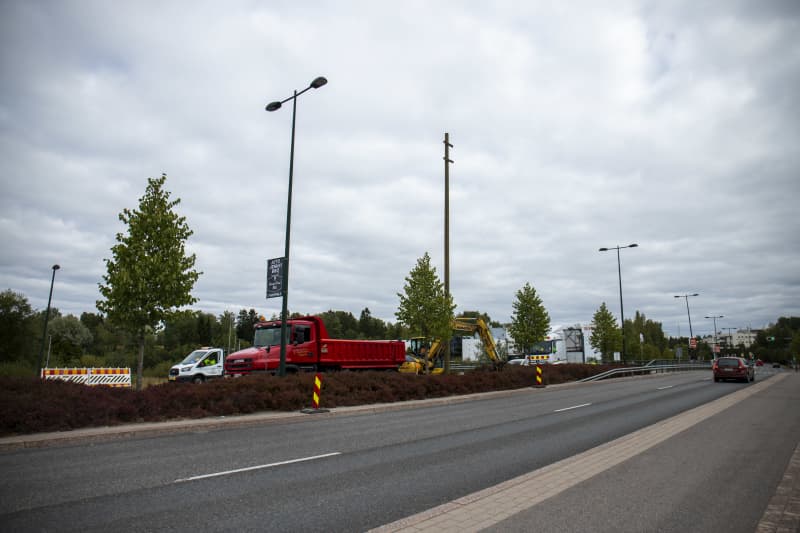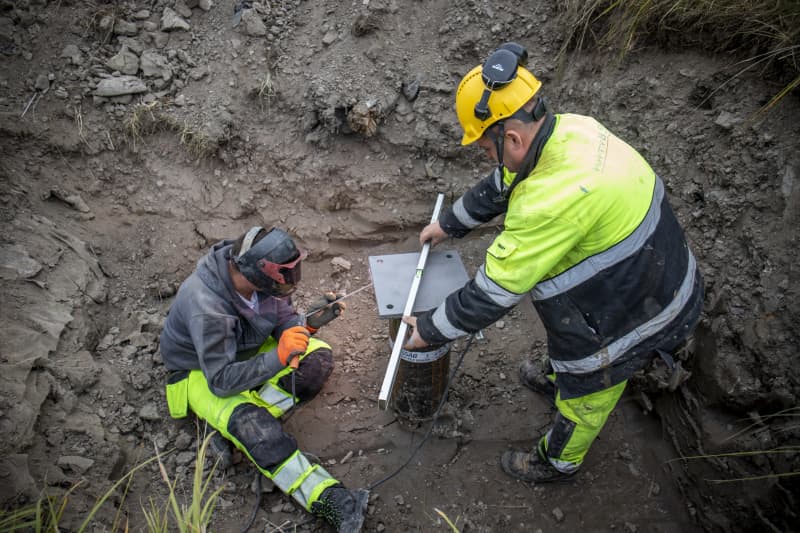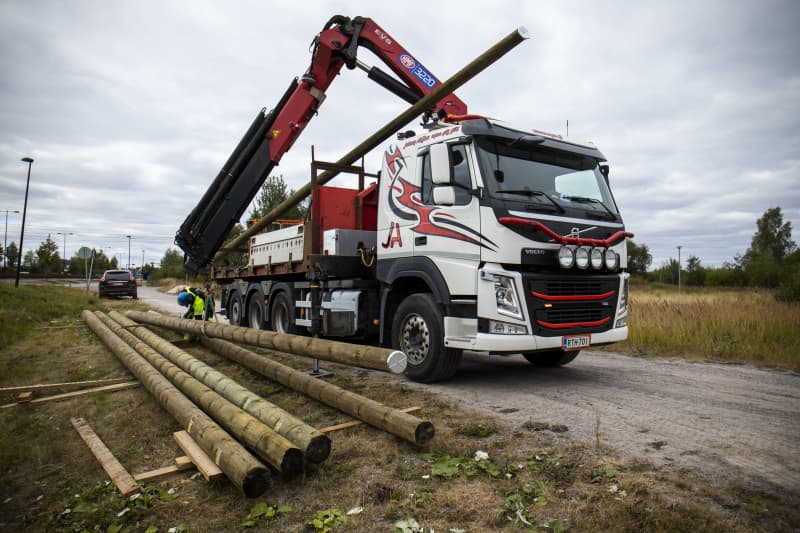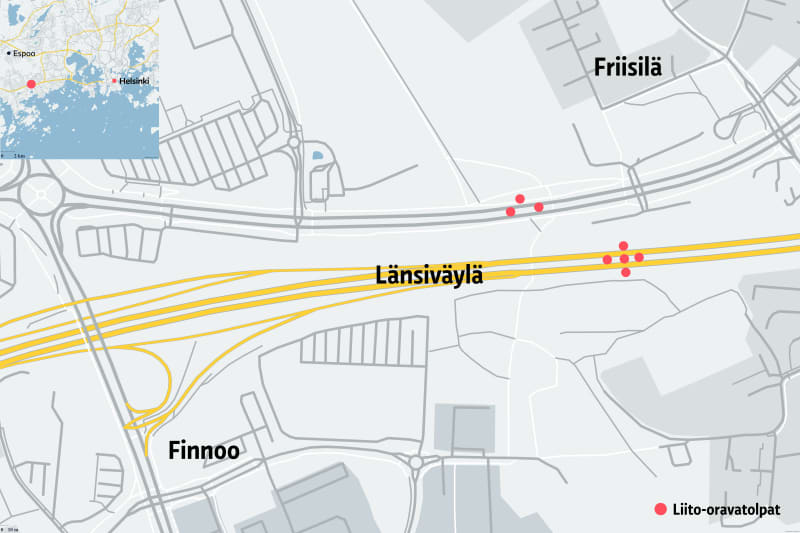There are various types of flying squirrel posts in several places around Finland, but there is no evidence that any flying squirrel has ever used them.
The wood grab of the crane truck grabs a 15-meter high impregnation wood post on Kuitinmäentien in Espoo. However, this is no ordinary electricity pole. At the end of the post there are two cross-beams of just under a meter for flying squirrels.
In Finland and the capital region as well, there are already quite a variety of implementations for flying squirrel poles.
– There are such design versions and some consultants even suggest metal poles. In Espoo’s Laajalahti, there are real pines like that, which have been stuck upright to grow, Lundgren lists.
The poles that are being erected now aim to connect the Finnoo bird wetland from the south and the northern side of the seashore to the Friisinkallio nature reserve and the Espoo Central Park. The area is an official provincial ecological connection, even at the provincial level.
– On both sides of the Länsiväylä there is a veritably vibrant population of flying squirrels. The path is of course also intended for other animals, for example badgers and roe deer.
The purpose is to add a considerable number of trees to the natural area. They are needed for flying squirrels, but they also provide protection for other animals and a more interesting environment for city dwellers to move around, Lundgren states.
\”The poles are the last option\”
In Espoo, the movement of flying squirrels and the vitality of tree trunks are primarily supported by planting trees. The trees have been densified near the existing flight paths of the flying squirrel, e.g. Westend’s Suvisillata and Latokaskenniitty.
However, trees cannot be planted right on the side of roads.
– A large tree on the sides of the roads and in the middle lanes would obstruct the view. Conifers or leaves and branches drip from them, they affect lights and shadows, and in winter they can drip snow and ice. Right next to the road, the trees would also have no room to grow, and without proper roots, the tree will not grow, Lundgren reasons.
For Finnoo, a pole is the only option for crossing Länsiväylä.
– The post also has a safety structure for impact. They break more controlled if a car hits them, Lundgren adds.

\”Everything has been studied and considered\”
The suitability or functionality of the poles for flying squirrels has not been proven in any way.
– With video cameras and game cameras, attempts have been made to obtain image material that would show that the flying squirrel is passing there. However, flying squirrels have not been recorded for any of them, Lundgren states.
It has been proven that the flying squirrel has somehow managed to cross the Länsiväylä at least at Suvisillata in Espoo, even without a pole.
– With the help of radio collar signals, evidence has been obtained that the same individual has been on both sides of the road, but of course there is no more detailed information about how the road was crossed. Nor does Espoo’s Suvisillata have a jumping pole, Lundgren elaborates.

So why go to great lengths to build poles that may well end up without connectors? The answer is simple: that’s what the Nature Conservation Act requires.
According to Lundgren, undercutting the road is not an option either, because flying squirrels live in trees. However, perhaps you could try to develop the column further.
– Some kind of rope, ladder or a small bridge between the posts could perhaps work. Such have been built in Australia for marsupials that move by climbing, Lundgren says.
However, nothing similar has been tried in Finland, because the current information is that the flying squirrel only moves by gliding. In addition, a rope or a small bridge over the road would pose a risk to traffic in Finnish conditions due to the snow and ice falling from them.
Three clear goals
According to Lundgren, Finnoo’s flying squirrels’ pole path has three clear goals.
– Only a certain number of flying squirrels can fit on the south side of Länsiväylä. Young flying squirrels have to languish in weak trees, probably starve or die prematurely from predation. Second, there is the need for gene exchange. An isolated strain would always be inbred.

According to Lundgren, the third point of view is the point of view of the people of Espoo.
– Since flying squirrels have the strictest possible species protection that can be found in Finland, we have to reach the so-called \”favorable protection level\”. If flying squirrels cannot cross the Länsiväylä from the south, a so-called partial population will form in the area, and then protection will become very difficult for the city and its citizens to implement, Lundgren clarifies.
In practice, the creation of a subpopulation would mean, according to Lundgren, that the felling of every single tree in the area should be considered very carefully and the effects of the felling on the protection of flying squirrels assessed.
– This is what we want to avoid, because at the same time that flying squirrels must be protected, the surrounding city must be able to develop, Lundgren reasons.
\”We wouldn’t try it at the city’s own expense\”
The usefulness of the flying squirrel’s jumping pole channel has therefore yet to be proven, and there are no guarantees of success. However, the experiment will not be paid directly from the wallets of Espoo taxpayers.

According to Lundgren, about 70 percent of the costs of planting trees and erecting poles have been paid by the EU’s Liito-orava-LIFE project. The rest is paid by the city of Espoo.
– Without EU support, this would not have been done. The city’s normal budget doesn’t allow you to try things like this, Lundgren states.
Soon, however, flying squirrels will not be seen on the Finnoo pole route. First, you have to wait for the trees to be planted on the route to grow to the necessary dimensions, more than ten meters.
– Tree saplings over six meters cost upwards of 10,000 euros, and in addition, special transport, special planting and special care would be needed, Lundgren clarifies.
Therefore, more smaller and cheaper seedlings are obtained. In addition, younger trees will probably adapt better to their new difficult growing place than older trees.
Flying squirrels enjoy themselves in Espoo
The flying squirrel is the mascot of Espoo and the city has invested in the protection of the species for years. Environmental expert Laura Lundgren estimates that there are around 2,000 of them living in the entire Espoo area.
– There are reports and pictures of how people have seen flying squirrels on their balconies and climbing the plastered walls of apartment buildings, Lundgren says.
It seems that the flying squirrel is well adapted to city life. According to Lundgren, no noise, light, people or dogs seem to disturb them. But how do the people of Espoo feel about their titular animal?
– It’s not a pity as long as you don’t have to cut down your own yard trees, Lundgren laughs.
_You can discuss the topic until Sunday 11.9. until 23:00._

